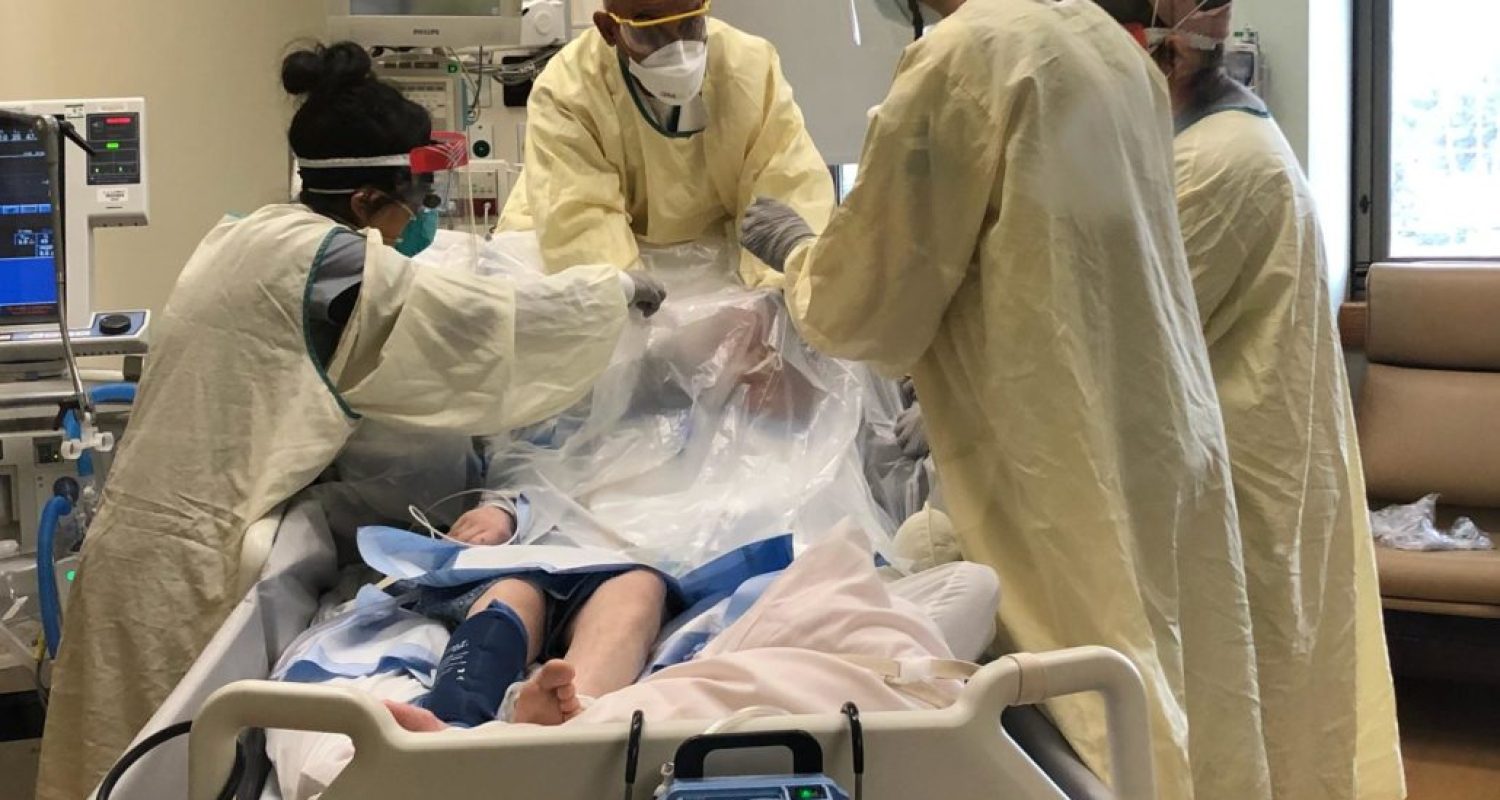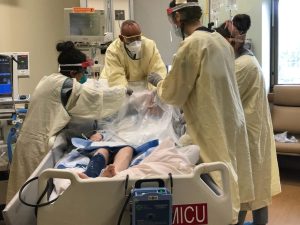COVID-19 in Medical Intensive Care

By H. Bryant Nguyen, MD
We all heard about COVID-19 on the news — with the first case in China, in Italy, in the U.S., in California, and then in San Bernardino. Our first confirmed case in the Medical Intensive Care Unit (MICU) at Loma Linda University Medical Center (LLUMC) was admitted on March 26, 2020.
Why MICU for COVID-19 patients? As we know, the most severe complication of COVID-19 infection is the Acute Respiratory Distress Syndrome (ARDS). These patients require mechanical ventilation with full life support, including multiple vasopressors. At times the ventilator is not enough. Other treatment strategies may include nitric oxide, proning, and/or extracorporeal membrane oxygenation (ECMO). Our physicians, nurses, respiratory care practitioners, and pharmacists are most experienced at treating patients with this condition in the MICU long before the pandemic. It is our bread and butter! Logistically, Unit 4700 (MICU) is the only adult ICU at LLUMC with single-patient rooms. Thus, our team became the naturally designated location for the critically ill COVID-19 patients. However, COVID-19 is different. The typical ARDS from other viral infections is not associated with the massive cytokine storm and/or clotting tendency that we all heard or read about. Multiple mechanistic hypotheses exist, from angiotensin-II converting enzyme (ACE-II) receptor activation to cytokine release to hemoglobin chain defects. But we truly don’t know yet the unifying pathogenesis of this virus.
Importantly, the pandemic has given us the opportunity to collaborate and bond with our community of intensivists locally at LLUH, regionally in Southern California, and nationally. Under the leadership of Chief of Patient Safety & Reliability Ihab Dorotta, MD, we discussed, debated, and commiserated daily on the topics of N95 vs. PAPR for high risk procedures and other questions. Who can or cannot participate in a code blue (i.e. cardiopulmonary resuscitation)? How will we manage a potential for hundreds of ICU patients system wide? Who can provide critical care when we exhaust our pool of intensivists? What treatment protocols do we develop when there is no known effective treatment? We were all prepared to drop other responsibilities to focus on COVID-19. We quarantined ourselves from our families when we came home. Some of us didn’t come home at times and stayed in hotels. What if 25% of us intensivists become infected as noted by our colleagues in Washington state and New York City? We soon found that every intensivist in the country was talking about these same issues. I remember Augustine M.K. Choi, MD, provost and dean of Cornell University, emailing the membership of the American Thoracic Society (ATS) with his personal mobile phone number and pleading, “I am reaching out to see whether ATS can help informing the members that we are running out of ICU trained doctors in NYC and desperately need to get outside ICU trained physicians. Governor Cuomo can approve all credentialing and licensing the same day. We have 1,000 patients in hospital (entire NYP system) with COVID-19, and I have 260 intubated patients in ICU. We are running out of ICU trained doctors.”
COVID-19 gave us all a chance to grow out of our comfort zones in taking care of patients. We experienced a dawning realization: this was our time! It was our time to answer God’s calling to be at the front line. It was our time to pull together as friends and colleagues. It was our time to learn to care for COVID-infected trauma, OB-GYN, cardiac surgery, and neurosurgical patients. At our peak census, our non-COVID-19 patients overflowed to the surgical ICU. Thus, in a role reversal, our surgical intensivists found themselves taking care of the DKA and severe COPD patients. We found ourselves working together in new ways. I returned to the hospital at 3 a.m. one morning to perform a bronchoscopy with trauma surgeon and intensivist Kaushik Mukherjee, MD, on a COVID-19 patient with severe hemoptysis. We spent more than two hours elbow-to-elbow, removing blood clots from the patient’s bronchial tree in full PPE gowns and masks. The sustained proximity during a tense and dangerous time created an unexpected bond between us.
To overcome the daily strain of participating in meetings, developing protocols, debating testing and treatment options, reading about COVID-19 (including the news and social media), updating the team, all on top of direct patient care, it was necessary for us to deploy humor. Levity, hugs, laughs, and smiles enabled us to keep our fears in perspective. We took many photos to memorialize a time of historic importance and of personal growth.
Fortunately, we have not experienced the surge of COVID-19 patients that we expected. As of July 27, 2020, our census in the MICU has approximated 20-30 COVID-19 patients on any given day. While our case load is nowhere close to that of New York City or other parts of the world, we have utilized treatments that have potential benefits, including hydroxychloroquine, corticosteroid, tocilizumab, anakinra, anticoagulation, plasma exchange, convalescent plasma, and even hyperbaric oxygen. The exponential pace of this epidemic has evoked the need for exponential response and actions. Remdesivir now gives us a toehold based on clinical trials. Should we be using other unproven therapies? I often asked myself, “What if the dying patient was my own family member, and there was no other choice?”

Vice President for LLUH Research Michael Samardzija, MD, and the Research Affairs team have kept regular contact with me, helping us secure clinical trials. We attempted to join a number of studies, including Gilead’s and NIH’s trials on remdesivir. Our clinical trials experience and preparedness were not the problem per the sponsors, but our patient volume was initially too low for the required rapid enrollment. At present, we are participating in three clinical trials examining novel therapies with varying mechanisms of action against COVID-19. We also have participated in a national registry led by the Brigham & Women’s Hospital at Harvard University with a manuscript recently published in JAMA Internal Medicine and several others in peer-review with high impact journals. The LLUH Institutional Review Board (IRB) approved the protocol within 36 hours of us expressing our intent to join the study. Interventional pulmonologist and intensivist Ara Chrissian, MD, is also maintaining an IRB-approved registry at LLUMC of all tested patients to compare non-COVID-19 vs. COVID-19 lower respiratory tract infections. Collectively, our group has contributed toward an invention at LLUH by intensivists Darcy J. Mainville ’15, Borin Hou, MD, and Kaushik Mukherjee, MD, for the “Copperhead” device to use during intubation. This device has absolutely kept us safe from the threat of COVID-19.
COVID-19 has been a historic detriment to our society with respect to taking people’s lives, impacting the economy, and changing how we view public health in general. But it also has given us a lifetime opportunity to deliver on our Loma Linda University medical oath to its fullest: “Acting as a good steward of the resources of society and of the talents granted us, we endeavor to reflect God’s mercy and compassion by caring for the lonely, the poor, the suffering, and those who are dying.”
At the bedside, on the phone, early in the morning, late at night, we have faced the test of our time. Through our fatigue and tears, we have come together. We have met our challenge. We have made a difference.
 Dr. Nguyen is the John E. Peterson Professor of Medicine and Head of Pulmonary & Critical Care Medicine at Loma Linda University Health. He is also the Director for the Medical Intensive Care Unit, where critically ill patients with COVID-19 are cared for at LLUMC.
Dr. Nguyen is the John E. Peterson Professor of Medicine and Head of Pulmonary & Critical Care Medicine at Loma Linda University Health. He is also the Director for the Medical Intensive Care Unit, where critically ill patients with COVID-19 are cared for at LLUMC.

